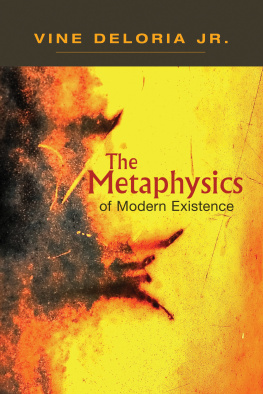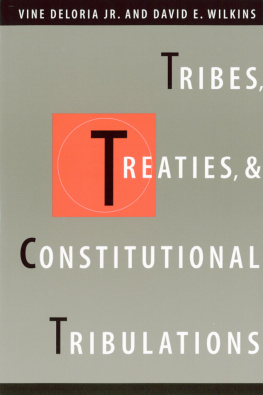Thank you for downloading this Simon & Schuster ebook.
Get a FREE ebook when you join our mailing list. Plus, get updates on new releases, deals, recommended reads, and more from Simon & Schuster. Click below to sign up and see terms and conditions.
CLICK HERE TO SIGN UP
Already a subscriber? Provide your email again so we can register this ebook and send you more of what you like to read. You will continue to receive exclusive offers in your inbox.
We hope you enjoyed reading this Simon & Schuster ebook.
Get a FREE ebook when you join our mailing list. Plus, get updates on new releases, deals, recommended reads, and more from Simon & Schuster. Click below to sign up and see terms and conditions.
CLICK HERE TO SIGN UP
Already a subscriber? Provide your email again so we can register this ebook and send you more of what you like to read. You will continue to receive exclusive offers in your inbox.

ABOUT THE AUTHOR
V INE D ELORIA , J R ., famous as an Indian rights advocate and former Executive Director of the National Congress of American Indians, is the author or editor of several popular and persuasive books, including American Indian Policy , published by the University of Oklahoma Press.

Scribner
An Imprint of Simon & Schuster, Inc.
1230 Avenue of the Americas
New York, NY 10020
www.SimonandSchuster.com
Copyright 1969, 1988 by Vine Deloria, Jr.
Copyright renewed 1997 by Vine Deloria, Jr.
Portions of Chapters 1 and 4 were first published in Playboy
All rights reserved, including the right to reproduce this book or portions thereof in any form whatsoever. For information address Scribner Subsidiary Rights Department, 1230 Avenue of the Americas, New York, NY 10020
First Scribner ebook edition August 2017
SCRIBNER and design are registered trademarks of The Gale Group, Inc. used under license by Simon & Schuster, Inc., the publisher of this work.
The Simon & Schuster Speakers Bureau can bring authors to your live event. For more information or to book an event contact the Simon & Schuster Speakers Bureau at 1-866-248-3049 or visit our website at www.simonspeakers.com.
ISBN 978-1-5011-8823-7 (ebook)

PREFACE
The Indian world has changed so substantially since the first publication of this book that some things contained in it seem new again. In the late sixties American society had yet to hear the voices, demands, and aspirations of the American Indians. The country was embroiled in the Civil Rights movement, and the anti-war protests were just gaining momentum. In some ways the emergence of Indians was a relief from the pressing demands of other, larger groups, but this relief was short-lived when Indians occupied first Alcatraz, then the Bureau of Indian Affairs headquarters in Washington, D.C., and finally the little hamlet of Wounded Knee on the Pine Ridge Reservation in South Dakota. Indians raised the question of the American past, and since this bloody past was then being revived in the search-and-destroy missions in Vietnam and in incidents such as that at Kent State, it was apparent that few people in the government heeded the lessons of history.
In the early seventies Indian tribal sovereignty was tacitly admitted, but it was not the cornerstone of federal policy, and termination under many new disguises was still the official direction toward which the Bureau of Indian Affairs was encouraged to move. A major effort to define a new Indian policy was made with the authorization of the American Indian Policy Review Commission in 1975, but after two years of intense maneuvering and many hearings, the commission report emphasized a number of adjustments of existing relationships and could not reach a consensus on establishing a clear and workable definition of how Indians and the federal government should deal with each other. Excessively aggressive arguments raised by the American Indian Policy Review Commission may, in fact, have helped spawn the many anti-Indian groups who are now agitating for complete abrogation of special tribal status.
Some of the recommendations made two decades ago in Custer Died for Your Sins did find their way into federal policy, in particular the subcontracting provisions of P.L. 635 which allowed tribal governments to assume responsibility for some of the functions of the Bureau of Indian Affairs. But, as might have been suspected, the bureau quickly worked out ways to co-opt and frustrate Indian efforts to take over programs and make them more capable of serving the reservation people. The biggest policy change in these intervening years, contained in President Richard M. Nixons July, 1970, message to Congress, was the official disavowal of termination as a formal goal of the federal government. Indeed, while Nixon may have failed in spectacular fashion in other aspects of his presidency, in retrospect his administration must be granted very high marks for its Indian policy. In responsiveness to Indian aspirations, it will probably be seen as the best administration in American history, and in terms of its accomplishments it should be ranked close to the New Deal, which radically turned the tide in favor of Indians. In comparison to recent administrations, the Nixon years are exceedingly bright and filled with accomplishments.
The cast of characters in Indian Affairs has also changed significantly in these past two decades. The Indian political scene in the 1960s was a fine blend of the first large generation of college-trained Indians and the entrenched veterans of the New Deal who had served most of their lives in tribal government. With the passing of the old guard and the subsequent delivery of tribal councils to the new generation, Indian tribes lost a good deal of their historical perspective. Long-standing Indian leaders such as Frank Ducheneaux of Cheyenne River, Joe Garry of Coeur dAlene, Cato Valandra of Rosebud, Bob Jim of Yakima, Lucy Covington of Colville, J. Dan Howard of Standing Rock, and Norbert Hill, Sr., of Oneida once formed a group that not only controlled much of Indian policy but also provided sage advice and acted as models for the younger generation. These people had read Felix S. Cohens Handbook of Federal Indian Law by kerosene light in log cabins and were as competent in the niceties of legal fictions as most attorneys then representing the tribes. Today, unfortunately, few people in tribal government know their legal rights; they simply assume their duties and responsibilities, and it makes the situation worse that there are few models from whom they can take their cues.
Public attitudes toward Indians, sadly, have changed very little in the intervening years. Assertion of historic rights by the tribes has only produced rabid backlash against Indians in many parts of the United States. Bumper stickers reading, Save the deer, shoot an Indian, are prominently featured in Wisconsin and Michigan as treaty hunting and fishing rights are successfully upheld in the courts. State politicians in South Dakota stand adamantly opposed to any just solution of the Sioux land claims in that state. Even in the most enlightened parts of our country there is still controversy over practicing tribal religions, wearing long hair in a traditional manner, and allowing Indians access to national parks and forests for the practice of traditional religion at sacred sites in those areas. The federal government itself, in trying to solve the Hopi-Navajo land dispute, has authorized the largest forcible removal of Indians in more than a century. So, while the attitudes originally identified two decades ago are still rampant among us, it makes good sense to keep Custer in print until enough people come to understand Indians attitude toward their treatment and begin to take action on behalf of the tribes.
Next page








